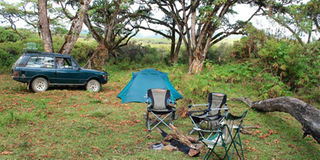Weekend camping inside the Aberdares

The KWS Hargenia Special Campsite. PHOTO| JAN FOX
What you need to know:
- My brother, Andreas, is a private safari guide, and he planned the Aberdares excursion as a recce for a future trip with Mzee up Mount Kenya.
- His usual safari vehicle is too heavy to run at such altitudes, so he will have to put his faith in Mzee instead.
With a full service, though including the removal of a rat’s nest behind one of the headlights, Mzee was given a new lease of life for the Aberdares trip.
Many of you will be familiar with Mzee, our old 1976 Range Rover. Mzee has featured heavily in this column over the 30 or so years that it has been running, and his trips have tended to generate more interest from readers than your average ‘Going Places’ article. We received lots of emails, in particular, after our journey with Mzee from Mombasa to Johannesburg in 2011. People were surprised that we made it to Jo’burg in just six days, especially in a car that had suffered the worst of Kenya’s roads.
Since he made the return journey through Botswana in 2014, Mzee has spent most of his time gathering leaves and rats in our garden. We’d drive him round the block occasionally to make sure that he was still alive, but he rarely ventured out of Lavington. During these quiet years, he really started to live up to his name as a wheezing, spluttering old man, with leaky pipes and a drinking problem. We didn’t give up on him though, and decided to bring him out of retirement for a trip up the Aberdares.
My brother, Andreas, is a private safari guide, and he planned the Aberdares excursion as a recce for a future trip with Mzee up Mount Kenya. His usual safari vehicle is too heavy to run at such altitudes, so he will have to put his faith in Mzee instead. With a full service, though including the removal of a rat’s nest behind one of the headlights, Mzee was given a new lease of life for the Aberdares trip.
We opted to approach the park from the east – from the Treetops gate and through the forested salient. Now that the Kenya Wildlife Service has ditched the smartcard system, and accepts card or M-Pesa payments, you can access the park from most gates without the inconvenience of visiting headquarters first.
The lower-altitude salient is more densely populated with wildlife than the moorlands running down the spine of the park. Herds of elephant and buffalo often congregate at the waterholes in front of the famous tree-hotels: The Ark and Treetops. On our last visit to The Ark, we were lucky enough to spot a female leopard and her cub, on the main road a few hundred metres from the lodge.
With the roof hatch open, Mzee was back in his element: chugging along dusty tracks through thick bush, without another vehicle in sight. After disturbing a giant forest hog in the undergrowth by the side of the road, we pulled into the Bongo Campsite for lunch.
FANTASTIC CAMPING SPOT
There are accommodation options to suit all budgets in the Aberdares, and the Bongo Campsite is just one of many fantastic camping spots across the park. We decided to spend the night at the KWS Hargenia Special Campsite, a few kilometres north of the Chania Falls.
The landscape changed quite dramatically between the salient and the higher-altitude Hargenia Campsite, which sits at about 10,000 ft. Swathes of striking purple Vernonia shrubs transitioned into dense bamboo forest, which then opened out to the moorlands the higher we climbed. En route, we came across groups of colobus and Sykes’ monkeys, and small caves by the road formed by elephants digging for natural salts with their tusks.
The campsite is shaded by a grove of beautiful Hagenia abyssinica trees, draped in pale green moss, or ‘Old Man’s Beard’. As we pitched our tents, a bold male bushbuck emerged from the bushes to graze a few metres away. Minutes later, he was joined by another male, and then by a couple of duikers, who were all as unconcerned by our presence as the first bushbuck. These welcome visitors browsed around our camp all night, and at one point barked in alarm at a passing hyena. I should say that a KWS ‘Special Campsite’, costs more than the park’s public campsites, and needs to be booked in advance.
Up here, the temperature plummets at night, so we were keen to see whether Mzee would start up in the morning. Thankfully, he did, and we were able to explore the moorlands. On the rolling plains of tussock grass, we spotted a lone elephant, and even caught a glimpse of an aardvark before it disappeared into its hole.
One of the attractions of the moorlands is the option to explore some of it on foot. On the Kinangop Plateau, it’s possible to walk to the top of the magnificent Karuru Falls. From here, on a clear day, you can also see Gura Falls in the distance – Kenya’s tallest cascade (305m). There are other scenic waterfalls too such as Chania and Magura Falls, by the Queen’s Cave.
There are some exceptional trekking opportunities in the high moorlands, as adventurous visitors can (with advance permission and a ranger) hike up the three main peaks: Lesatima (4001m), Il Kinangop (3906m), and Kipipiri (3349m).
For more information, visit the KWS website: www.kws.go.ke.
Jan Fox is a Director at iDC





